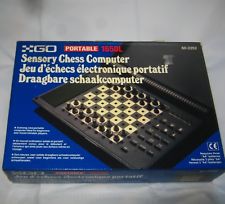

Check out this well-designed game for a worthy opponent.

Well-worn advice says that the best way to improve your skills in any competitive activity is to play against someone better than yourself. When I'm hopelessly backed into a corner, ready to surrender, I have it play my side: 'If you're so smart, let's see you get out of this one!' And it does. The device lets you choose which side the computer plays on, a handy trick if you're being trounced. Select its dumbest setting and the computer responds with a good move the instant you finish yours. Select its smartest setting and the computer may take up to five minutes to make a killer move. You can also adjust the 'depth' of the computer's search for a solution. Viewing physical pieces on the board is comforting for amateur players like myself. The computer displays its move on a small LCD screen you have to physically move its piece on the board to match the screen. When you thump your piece down after each brilliant move, the computer gizmo registers it and then calculates its more brilliant counter-move - within seconds. You set up the chess pieces on an electronically sensitized board. The device is user-friendly, even though it can beat your pants off. You'd have to be awfully good to whip this tray-size wonder.
#Chess champion 2150l user manual portable
What everyone doesn't know is that a computer chess playing program that can already beat about 97 percent of ordinary mortal players is available today as a portable electronic gizmo down at your local Radio Shack store.

Yet, as everyone seems to know, no computer program built yet can beat a human chess grand master. The crystal logic of the game of chess made it a perfect test-bed for experiments in machine intelligence. The history of computing can be told as the history of chess playing programs.


 0 kommentar(er)
0 kommentar(er)
